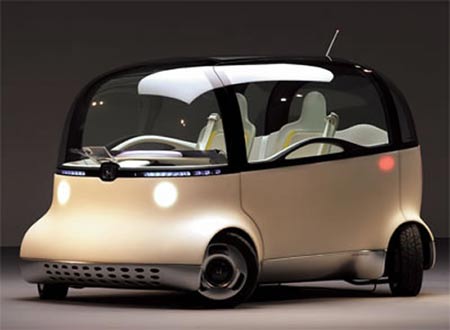The Honda Puyo is an interesting concept car. When I think about cars in the future, this is the kind of thing I imagine visually.
In the future I imagine our cars will transition from being extensions and avatars of our selves to being more like intelligent partners. With the introduction of artificial intelligence and sophisticated navigation into automobiles, we will cede more control of the driving experience to our vehicles who will drive for us to take us where we want to go. After all, the point is to get somewhere whenever you like. Most people could care less about the actual driving part. With the car driving itself, you could sit back and nap or entertain yourself. No need to focus on the road because someone else will be driving.
In a way, this new partnership with our vehicles harkens back to the days when you rode astride your trusty steed to get from place to place. Even though you steered and told the horse where to go, it took care of the actual movement on its own and was pretty good at avoiding obstacles. You could even fall asleep in the saddle.
In the future, your silicon steed will probably have a distinct personality, voice, and name. Instead of starting up your loud, fossil-fuel-burning machine and driving yourself, you will approach the car, the doors will open for you, and you will say something like “Henry, pick up Jane and then drop us off at the movie theatre on Mockingbird Lane.” Then your car, Henry or whatever you name it, will do the rest while you check your email or play a game. I don’t think this is far off. We have most of the technological pieces in place.
DARPA has funded a project over the last several years to promote the development of autonomous driving vehicles. We have developed systems that can successfully drive cross-country. In November 2007, DARPA’s Urban challenge will take place on a course with traffic. The autonomous vehicles will need to avoid other cars and obey normal traffic laws.
It will consist of a 60 mile course on primarily paved roads, but this time, the vehicles will have to drive in traffic. They will have to stop at stop signs, look for other vehicles, obey the rules of precedence at intersections, obey traffic laws (don’t cross double yellow center lines), pass other stationary and slow moving cars, back up, park, make a U-turn and plan a new course when the main road is blocked, and take evasive action if a collision with another vehicle is imminent. Sort of makes a 132 mile drive on a closed course in the desert seem like a walk in the park.
The military’s interest in autonomous driving has to do with the desire to have robotic convoys who can travel through dangerous territory. Congress has mandated that one third of the US military’s ground vehicles must be able to operate autonomously by 2015, so this technology will quickly be a reality.
If we are improving so much year over year, it would not take long for this technology to enter the marketplace. We will probably ease into it with something like driver-assist and then it will just get better and better. As soon as cars can drive themselves, many of our traffic issues will improve due to removing the inefficiencies caused by bad driving.
Once we create cars that can drive themselves, then we can focus on the next step, which is to turn cars into a commodity rather than something everyone needs to own. It is highly inefficient for everyone to own a separate 3000-6000 lb vehicle that they only use for an hour a day. If cars could drive themselves, you could create a system where groups of people could fractionally own a vehicle or where you could order car service on demand from several nearby cars for hire.
